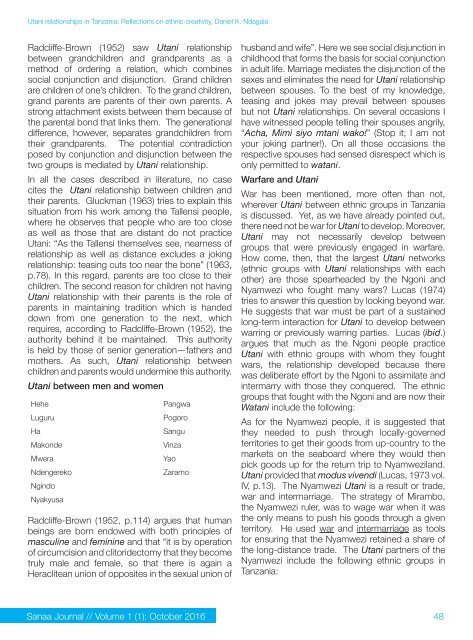African Arts Media Cultures
SanaaJournalIssue1Vol.1
SanaaJournalIssue1Vol.1
Create successful ePaper yourself
Turn your PDF publications into a flip-book with our unique Google optimized e-Paper software.
Utani relationships in Tanzania: Reflections on ethnic creativity, Daniel K. Ndagala<br />
Radcliffe-Brown (1952) saw Utani relationship<br />
between grandchildren and grandparents as a<br />
method of ordering a relation, which combines<br />
social conjunction and disjunction. Grand children<br />
are children of one’s children. To the grand children,<br />
grand parents are parents of their own parents. A<br />
strong attachment exists between them because of<br />
the parental bond that links them. The generational<br />
difference, however, separates grandchildren from<br />
their grandparents. The potential contradiction<br />
posed by conjunction and disjunction between the<br />
two groups is mediated by Utani relationship.<br />
In all the cases described in literature, no case<br />
cites the Utani relationship between children and<br />
their parents. Gluckman (1963) tries to explain this<br />
situation from his work among the Tallensi people,<br />
where he observes that people who are too close<br />
as well as those that are distant do not practice<br />
Utani: “As the Tallensi themselves see, nearness of<br />
relationship as well as distance excludes a joking<br />
relationship: teasing cuts too near the bone” (1963,<br />
p.78). In this regard, parents are too close to their<br />
children. The second reason for children not having<br />
Utani relationship with their parents is the role of<br />
parents in maintaining tradition which is handed<br />
down from one generation to the next, which<br />
requires, according to Radcliffe-Brown (1952), the<br />
authority behind it be maintained. This authority<br />
is held by those of senior generation—fathers and<br />
mothers. As such, Utani relationship between<br />
children and parents would undermine this authority.<br />
Utani between men and women<br />
Hehe<br />
Luguru<br />
Ha<br />
Makonde<br />
Mwera<br />
Ndengereko<br />
Ngindo<br />
Nyakyusa<br />
Pangwa<br />
Pogoro<br />
Sangu<br />
Vinza<br />
Yao<br />
Zaramo<br />
Radcliffe-Brown (1952, p.114) argues that human<br />
beings are born endowed with both principles of<br />
masculine and feminine and that “it is by operation<br />
of circumcision and clitoridectomy that they become<br />
truly male and female, so that there is again a<br />
Heraclitean union of opposites in the sexual union of<br />
husband and wife”. Here we see social disjunction in<br />
childhood that forms the basis for social conjunction<br />
in adult life. Marriage mediates the disjunction of the<br />
sexes and eliminates the need for Utani relationship<br />
between spouses. To the best of my knowledge,<br />
teasing and jokes may prevail between spouses<br />
but not Utani relationships. On several occasions I<br />
have witnessed people telling their spouses angrily,<br />
“Acha, Mimi siyo mtani wako!” (Stop it; I am not<br />
your joking partner!). On all those occasions the<br />
respective spouses had sensed disrespect which is<br />
only permitted to watani.<br />
Warfare and Utani<br />
War has been mentioned, more often than not,<br />
wherever Utani between ethnic groups in Tanzania<br />
is discussed. Yet, as we have already pointed out,<br />
there need not be war for Utani to develop. Moreover,<br />
Utani may not necessarily develop between<br />
groups that were previously engaged in warfare.<br />
How come, then, that the largest Utani networks<br />
(ethnic groups with Utani relationships with each<br />
other) are those spearheaded by the Ngoni and<br />
Nyamwezi who fought many wars? Lucas (1974)<br />
tries to answer this question by looking beyond war.<br />
He suggests that war must be part of a sustained<br />
long-term interaction for Utani to develop between<br />
warring or previously warring parties. Lucas (ibid.)<br />
argues that much as the Ngoni people practice<br />
Utani with ethnic groups with whom they fought<br />
wars, the relationship developed because there<br />
was deliberate effort by the Ngoni to assimilate and<br />
intermarry with those they conquered. The ethnic<br />
groups that fought with the Ngoni and are now their<br />
Watani include the following:<br />
As for the Nyamwezi people, it is suggested that<br />
they needed to push through locally-governed<br />
territories to get their goods from up-country to the<br />
markets on the seaboard where they would then<br />
pick goods up for the return trip to Nyamweziland.<br />
Utani provided that modus vivendi (Lucas, 1973 vol.<br />
IV, p.13). The Nyamwezi Utani is a result or trade,<br />
war and intermarriage. The strategy of Mirambo,<br />
the Nyamwezi ruler, was to wage war when it was<br />
the only means to push his goods through a given<br />
territory. He used war and intermarriage as tools<br />
for ensuring that the Nyamwezi retained a share of<br />
the long-distance trade. The Utani partners of the<br />
Nyamwezi include the following ethnic groups in<br />
Tanzania:<br />
Sanaa Journal // Volume 1 (1): October 2016<br />
48


